Oncology Nursing: Side Effects of Chemotherapy and Interventions
VerifiedAdded on 2023/06/10
|8
|2483
|456
Essay
AI Summary
This essay provides a comprehensive overview of chemotherapy side effects in oncology nursing, focusing on patient care and intervention strategies. It begins by defining cancer and the role of chemotherapy, highlighting its mechanisms and common side effects such as alopecia, nausea, vomiting, and nerve damage. The essay emphasizes the importance of nursing interventions, including psychological counseling, patient education, and symptom management. It details the impact of alopecia on patients' self-esteem and the interventions, such as wigs and counseling, to address it. The essay also discusses other side effects like stomatitis and peripheral neuropathy, emphasizing the nurse's role in assessing, supporting, and providing emotional assistance to patients. The author shares clinical experiences, underscoring the importance of a positive approach and the use of pharmaceutical drugs to mitigate side effects. The essay concludes by reiterating the significance of holistic patient care and the nurse's role in improving the patient's quality of life throughout the cancer treatment journey.

Running head: ONCOLOGY NURSING
ONCOLOGY NURSING
Name of the Student:
Name of the University:
Author Note:
ONCOLOGY NURSING
Name of the Student:
Name of the University:
Author Note:
Paraphrase This Document
Need a fresh take? Get an instant paraphrase of this document with our AI Paraphraser
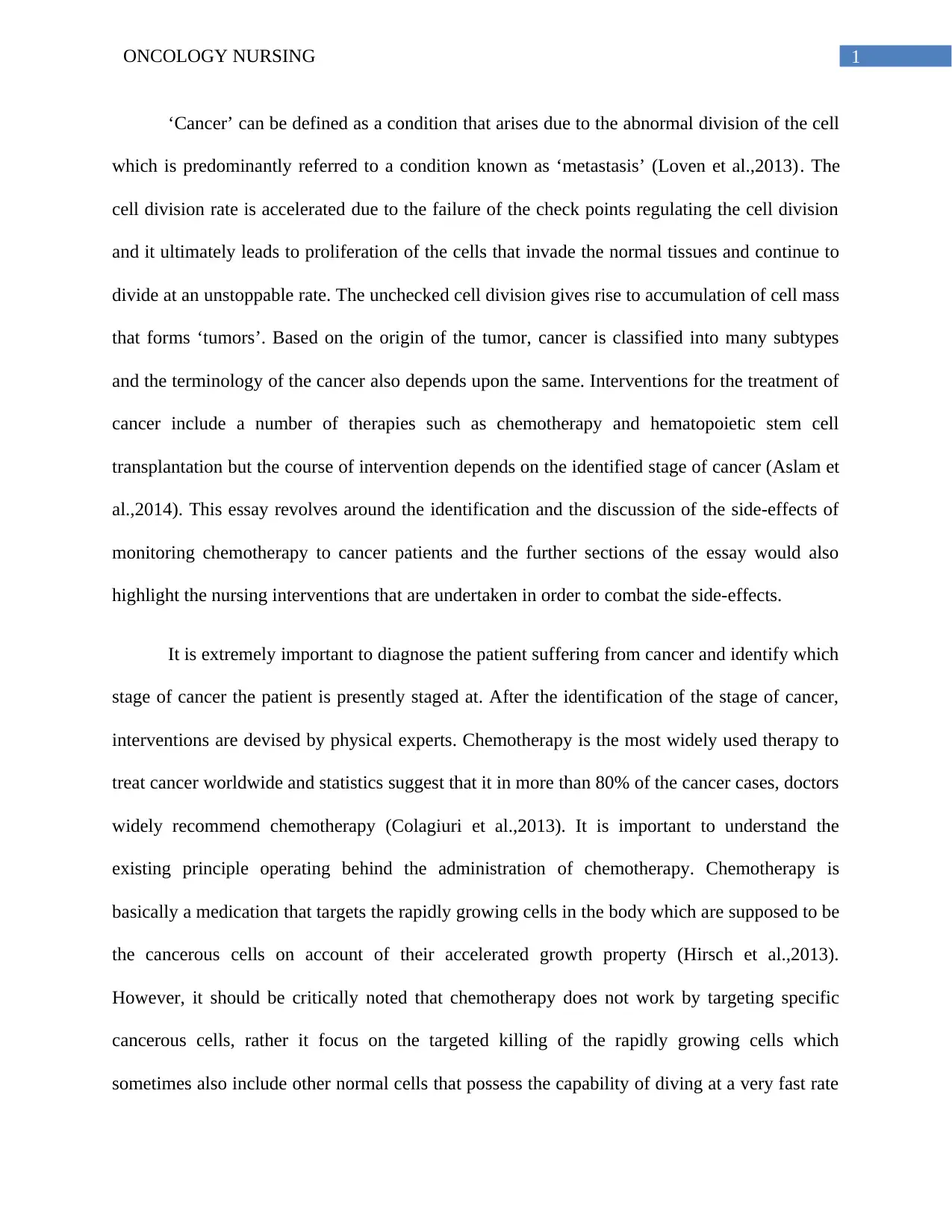
1ONCOLOGY NURSING
‘Cancer’ can be defined as a condition that arises due to the abnormal division of the cell
which is predominantly referred to a condition known as ‘metastasis’ (Loven et al.,2013). The
cell division rate is accelerated due to the failure of the check points regulating the cell division
and it ultimately leads to proliferation of the cells that invade the normal tissues and continue to
divide at an unstoppable rate. The unchecked cell division gives rise to accumulation of cell mass
that forms ‘tumors’. Based on the origin of the tumor, cancer is classified into many subtypes
and the terminology of the cancer also depends upon the same. Interventions for the treatment of
cancer include a number of therapies such as chemotherapy and hematopoietic stem cell
transplantation but the course of intervention depends on the identified stage of cancer (Aslam et
al.,2014). This essay revolves around the identification and the discussion of the side-effects of
monitoring chemotherapy to cancer patients and the further sections of the essay would also
highlight the nursing interventions that are undertaken in order to combat the side-effects.
It is extremely important to diagnose the patient suffering from cancer and identify which
stage of cancer the patient is presently staged at. After the identification of the stage of cancer,
interventions are devised by physical experts. Chemotherapy is the most widely used therapy to
treat cancer worldwide and statistics suggest that it in more than 80% of the cancer cases, doctors
widely recommend chemotherapy (Colagiuri et al.,2013). It is important to understand the
existing principle operating behind the administration of chemotherapy. Chemotherapy is
basically a medication that targets the rapidly growing cells in the body which are supposed to be
the cancerous cells on account of their accelerated growth property (Hirsch et al.,2013).
However, it should be critically noted that chemotherapy does not work by targeting specific
cancerous cells, rather it focus on the targeted killing of the rapidly growing cells which
sometimes also include other normal cells that possess the capability of diving at a very fast rate
‘Cancer’ can be defined as a condition that arises due to the abnormal division of the cell
which is predominantly referred to a condition known as ‘metastasis’ (Loven et al.,2013). The
cell division rate is accelerated due to the failure of the check points regulating the cell division
and it ultimately leads to proliferation of the cells that invade the normal tissues and continue to
divide at an unstoppable rate. The unchecked cell division gives rise to accumulation of cell mass
that forms ‘tumors’. Based on the origin of the tumor, cancer is classified into many subtypes
and the terminology of the cancer also depends upon the same. Interventions for the treatment of
cancer include a number of therapies such as chemotherapy and hematopoietic stem cell
transplantation but the course of intervention depends on the identified stage of cancer (Aslam et
al.,2014). This essay revolves around the identification and the discussion of the side-effects of
monitoring chemotherapy to cancer patients and the further sections of the essay would also
highlight the nursing interventions that are undertaken in order to combat the side-effects.
It is extremely important to diagnose the patient suffering from cancer and identify which
stage of cancer the patient is presently staged at. After the identification of the stage of cancer,
interventions are devised by physical experts. Chemotherapy is the most widely used therapy to
treat cancer worldwide and statistics suggest that it in more than 80% of the cancer cases, doctors
widely recommend chemotherapy (Colagiuri et al.,2013). It is important to understand the
existing principle operating behind the administration of chemotherapy. Chemotherapy is
basically a medication that targets the rapidly growing cells in the body which are supposed to be
the cancerous cells on account of their accelerated growth property (Hirsch et al.,2013).
However, it should be critically noted that chemotherapy does not work by targeting specific
cancerous cells, rather it focus on the targeted killing of the rapidly growing cells which
sometimes also include other normal cells that possess the capability of diving at a very fast rate
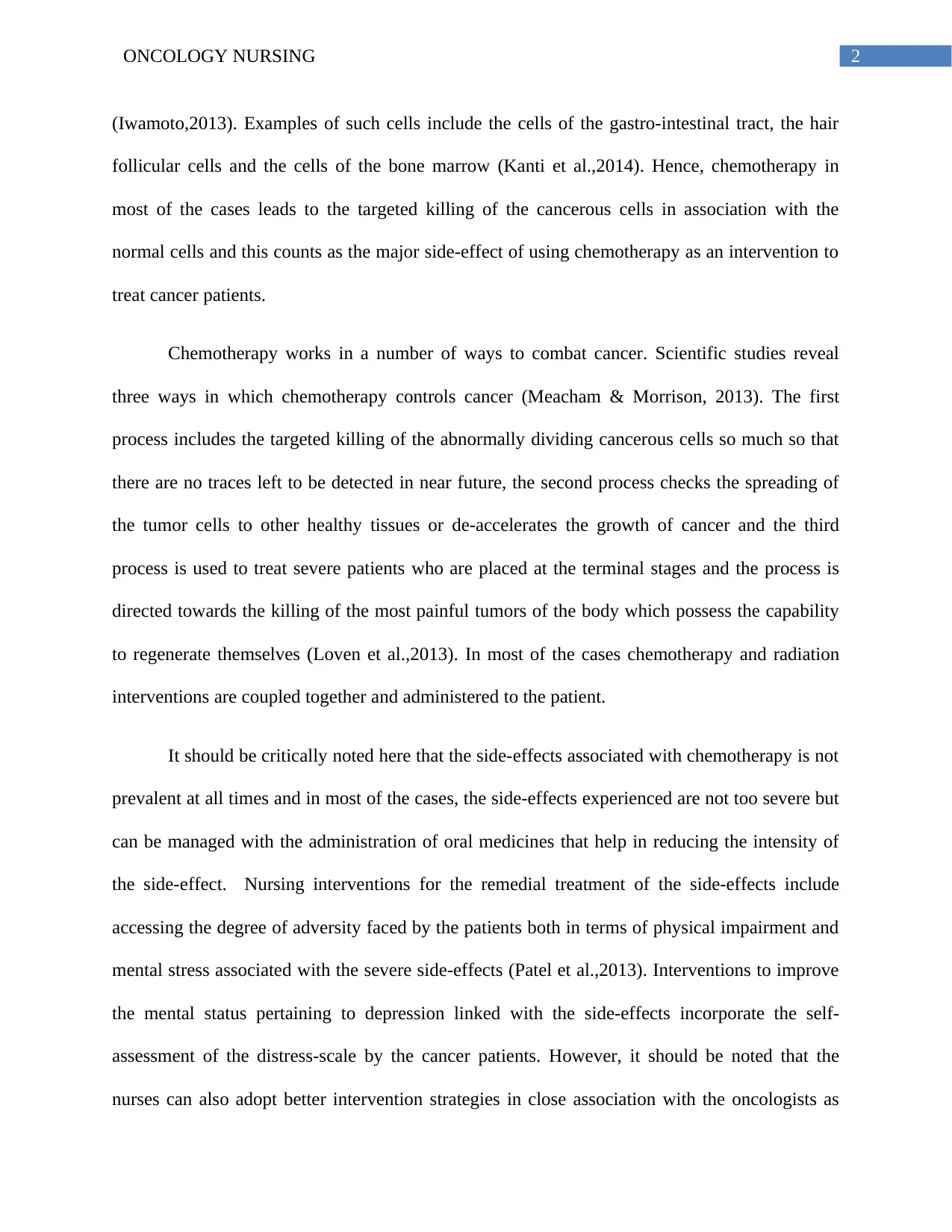
2ONCOLOGY NURSING
(Iwamoto,2013). Examples of such cells include the cells of the gastro-intestinal tract, the hair
follicular cells and the cells of the bone marrow (Kanti et al.,2014). Hence, chemotherapy in
most of the cases leads to the targeted killing of the cancerous cells in association with the
normal cells and this counts as the major side-effect of using chemotherapy as an intervention to
treat cancer patients.
Chemotherapy works in a number of ways to combat cancer. Scientific studies reveal
three ways in which chemotherapy controls cancer (Meacham & Morrison, 2013). The first
process includes the targeted killing of the abnormally dividing cancerous cells so much so that
there are no traces left to be detected in near future, the second process checks the spreading of
the tumor cells to other healthy tissues or de-accelerates the growth of cancer and the third
process is used to treat severe patients who are placed at the terminal stages and the process is
directed towards the killing of the most painful tumors of the body which possess the capability
to regenerate themselves (Loven et al.,2013). In most of the cases chemotherapy and radiation
interventions are coupled together and administered to the patient.
It should be critically noted here that the side-effects associated with chemotherapy is not
prevalent at all times and in most of the cases, the side-effects experienced are not too severe but
can be managed with the administration of oral medicines that help in reducing the intensity of
the side-effect. Nursing interventions for the remedial treatment of the side-effects include
accessing the degree of adversity faced by the patients both in terms of physical impairment and
mental stress associated with the severe side-effects (Patel et al.,2013). Interventions to improve
the mental status pertaining to depression linked with the side-effects incorporate the self-
assessment of the distress-scale by the cancer patients. However, it should be noted that the
nurses can also adopt better intervention strategies in close association with the oncologists as
(Iwamoto,2013). Examples of such cells include the cells of the gastro-intestinal tract, the hair
follicular cells and the cells of the bone marrow (Kanti et al.,2014). Hence, chemotherapy in
most of the cases leads to the targeted killing of the cancerous cells in association with the
normal cells and this counts as the major side-effect of using chemotherapy as an intervention to
treat cancer patients.
Chemotherapy works in a number of ways to combat cancer. Scientific studies reveal
three ways in which chemotherapy controls cancer (Meacham & Morrison, 2013). The first
process includes the targeted killing of the abnormally dividing cancerous cells so much so that
there are no traces left to be detected in near future, the second process checks the spreading of
the tumor cells to other healthy tissues or de-accelerates the growth of cancer and the third
process is used to treat severe patients who are placed at the terminal stages and the process is
directed towards the killing of the most painful tumors of the body which possess the capability
to regenerate themselves (Loven et al.,2013). In most of the cases chemotherapy and radiation
interventions are coupled together and administered to the patient.
It should be critically noted here that the side-effects associated with chemotherapy is not
prevalent at all times and in most of the cases, the side-effects experienced are not too severe but
can be managed with the administration of oral medicines that help in reducing the intensity of
the side-effect. Nursing interventions for the remedial treatment of the side-effects include
accessing the degree of adversity faced by the patients both in terms of physical impairment and
mental stress associated with the severe side-effects (Patel et al.,2013). Interventions to improve
the mental status pertaining to depression linked with the side-effects incorporate the self-
assessment of the distress-scale by the cancer patients. However, it should be noted that the
nurses can also adopt better intervention strategies in close association with the oncologists as
⊘ This is a preview!⊘
Do you want full access?
Subscribe today to unlock all pages.

Trusted by 1+ million students worldwide
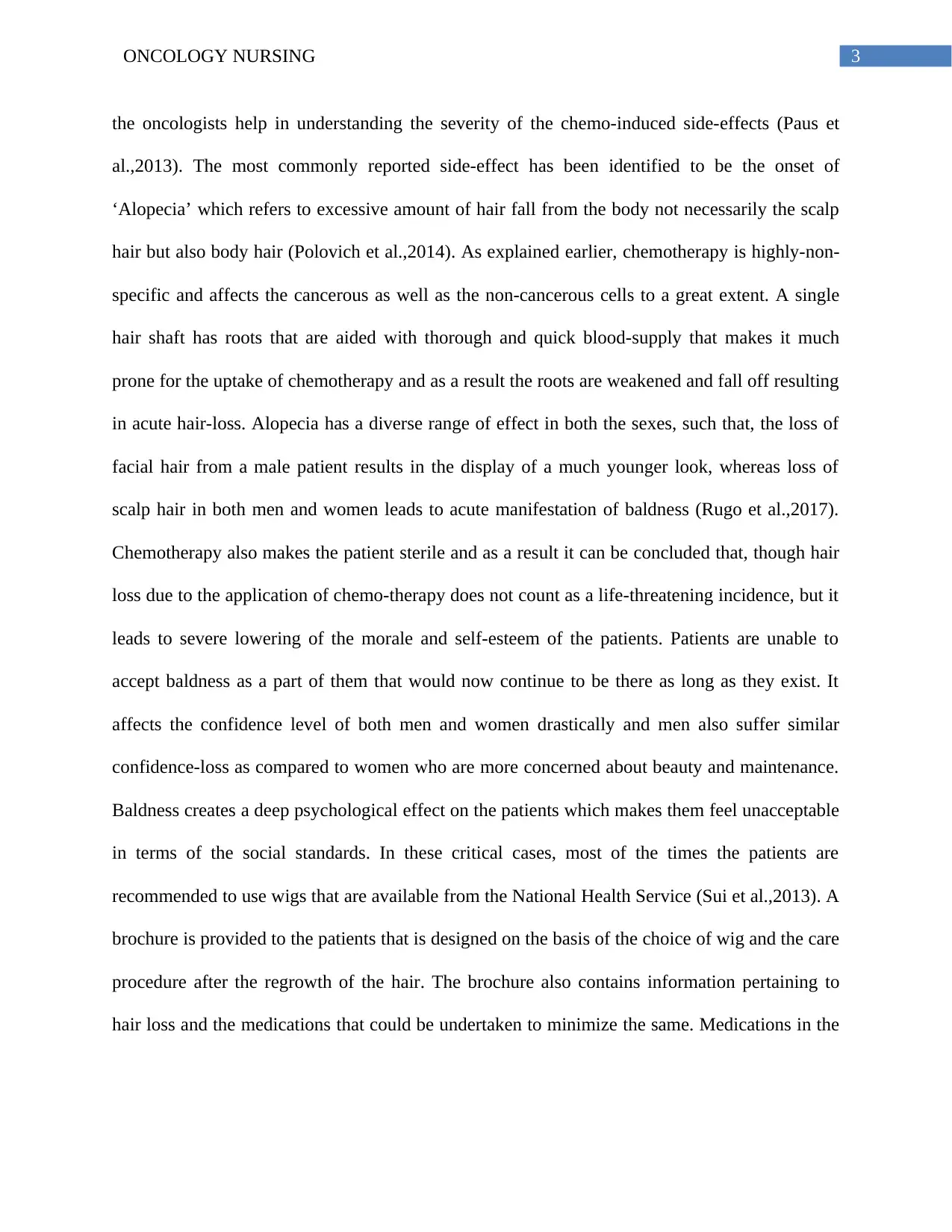
3ONCOLOGY NURSING
the oncologists help in understanding the severity of the chemo-induced side-effects (Paus et
al.,2013). The most commonly reported side-effect has been identified to be the onset of
‘Alopecia’ which refers to excessive amount of hair fall from the body not necessarily the scalp
hair but also body hair (Polovich et al.,2014). As explained earlier, chemotherapy is highly-non-
specific and affects the cancerous as well as the non-cancerous cells to a great extent. A single
hair shaft has roots that are aided with thorough and quick blood-supply that makes it much
prone for the uptake of chemotherapy and as a result the roots are weakened and fall off resulting
in acute hair-loss. Alopecia has a diverse range of effect in both the sexes, such that, the loss of
facial hair from a male patient results in the display of a much younger look, whereas loss of
scalp hair in both men and women leads to acute manifestation of baldness (Rugo et al.,2017).
Chemotherapy also makes the patient sterile and as a result it can be concluded that, though hair
loss due to the application of chemo-therapy does not count as a life-threatening incidence, but it
leads to severe lowering of the morale and self-esteem of the patients. Patients are unable to
accept baldness as a part of them that would now continue to be there as long as they exist. It
affects the confidence level of both men and women drastically and men also suffer similar
confidence-loss as compared to women who are more concerned about beauty and maintenance.
Baldness creates a deep psychological effect on the patients which makes them feel unacceptable
in terms of the social standards. In these critical cases, most of the times the patients are
recommended to use wigs that are available from the National Health Service (Sui et al.,2013). A
brochure is provided to the patients that is designed on the basis of the choice of wig and the care
procedure after the regrowth of the hair. The brochure also contains information pertaining to
hair loss and the medications that could be undertaken to minimize the same. Medications in the
the oncologists help in understanding the severity of the chemo-induced side-effects (Paus et
al.,2013). The most commonly reported side-effect has been identified to be the onset of
‘Alopecia’ which refers to excessive amount of hair fall from the body not necessarily the scalp
hair but also body hair (Polovich et al.,2014). As explained earlier, chemotherapy is highly-non-
specific and affects the cancerous as well as the non-cancerous cells to a great extent. A single
hair shaft has roots that are aided with thorough and quick blood-supply that makes it much
prone for the uptake of chemotherapy and as a result the roots are weakened and fall off resulting
in acute hair-loss. Alopecia has a diverse range of effect in both the sexes, such that, the loss of
facial hair from a male patient results in the display of a much younger look, whereas loss of
scalp hair in both men and women leads to acute manifestation of baldness (Rugo et al.,2017).
Chemotherapy also makes the patient sterile and as a result it can be concluded that, though hair
loss due to the application of chemo-therapy does not count as a life-threatening incidence, but it
leads to severe lowering of the morale and self-esteem of the patients. Patients are unable to
accept baldness as a part of them that would now continue to be there as long as they exist. It
affects the confidence level of both men and women drastically and men also suffer similar
confidence-loss as compared to women who are more concerned about beauty and maintenance.
Baldness creates a deep psychological effect on the patients which makes them feel unacceptable
in terms of the social standards. In these critical cases, most of the times the patients are
recommended to use wigs that are available from the National Health Service (Sui et al.,2013). A
brochure is provided to the patients that is designed on the basis of the choice of wig and the care
procedure after the regrowth of the hair. The brochure also contains information pertaining to
hair loss and the medications that could be undertaken to minimize the same. Medications in the
Paraphrase This Document
Need a fresh take? Get an instant paraphrase of this document with our AI Paraphraser

4ONCOLOGY NURSING
form of organic hair follicle regrow oil and gels are widely available at the dispensaries that is
mostly prescribed to the patients.
Nursing interventions also include psychological counseling sessions where in the
nursing professionals interact freely with the patients and provide important tips on the factors
that could be kept in mind to regrow the hair at a faster rate (Iwamoto,2013). Also. It is strictly
made sure that any discussion pertaining to the permanent loss of hair and the inability of the
follicles to ever regrow one strand of hair is avoided so that the patients do not feel de-motivated
and discouraged. Interactions involve discussing about all the physiological changes that the
patients tend to face and recording a patient history on the basis of it. Studies reveal that in many
cases, patients do not feel comfortable discussing about the physiological ambiguities they
experience after undertaking chemotherapy because they fear that it might to permanent stopping
of the chemotherapy session and that might lead to the occurrence of death much sooner (Paus et
al.,2013). Hence, the very initial process of clinical nursing intervention elucidates the
development of the emotional crisis that the cancer patient is undergoing and providing
emotional assistance accordingly at each and every step of the cancer treatment. Other side-
effects that are most commonly reported according to the data gathered through various scientific
discussion panels and journals includes issues related to ‘stomatitis’ which is basically identifies
as a condition when there is an acute inflammation in the oral cavity, complete distortion of
immunological responsiveness, chemotherapy induced diarrhea, nausea and vomiting, onset of
hypersensitivity and complete damage of nerve tissues so much so that there is no responsiveness
to external stimulus (Hirsch et al.,2013). Research papers have revealed two drugs, namely,
Oxaliplatin and Taxanes to cause peripheral nerve damage in cancer patients who underwent
chemo-therapy (Loven et al.,2013). Patients experiencing this problem have reported the feelings
form of organic hair follicle regrow oil and gels are widely available at the dispensaries that is
mostly prescribed to the patients.
Nursing interventions also include psychological counseling sessions where in the
nursing professionals interact freely with the patients and provide important tips on the factors
that could be kept in mind to regrow the hair at a faster rate (Iwamoto,2013). Also. It is strictly
made sure that any discussion pertaining to the permanent loss of hair and the inability of the
follicles to ever regrow one strand of hair is avoided so that the patients do not feel de-motivated
and discouraged. Interactions involve discussing about all the physiological changes that the
patients tend to face and recording a patient history on the basis of it. Studies reveal that in many
cases, patients do not feel comfortable discussing about the physiological ambiguities they
experience after undertaking chemotherapy because they fear that it might to permanent stopping
of the chemotherapy session and that might lead to the occurrence of death much sooner (Paus et
al.,2013). Hence, the very initial process of clinical nursing intervention elucidates the
development of the emotional crisis that the cancer patient is undergoing and providing
emotional assistance accordingly at each and every step of the cancer treatment. Other side-
effects that are most commonly reported according to the data gathered through various scientific
discussion panels and journals includes issues related to ‘stomatitis’ which is basically identifies
as a condition when there is an acute inflammation in the oral cavity, complete distortion of
immunological responsiveness, chemotherapy induced diarrhea, nausea and vomiting, onset of
hypersensitivity and complete damage of nerve tissues so much so that there is no responsiveness
to external stimulus (Hirsch et al.,2013). Research papers have revealed two drugs, namely,
Oxaliplatin and Taxanes to cause peripheral nerve damage in cancer patients who underwent
chemo-therapy (Loven et al.,2013). Patients experiencing this problem have reported the feelings
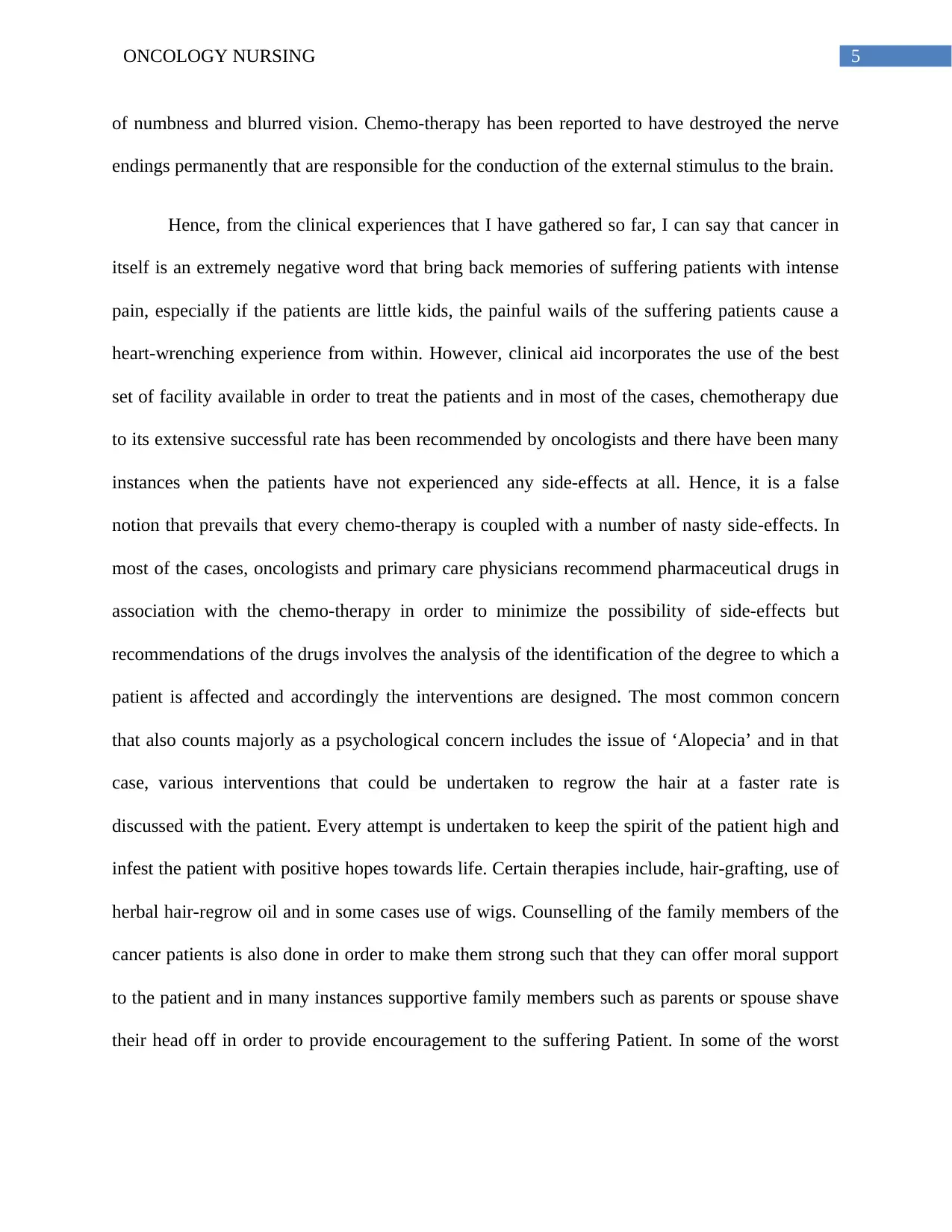
5ONCOLOGY NURSING
of numbness and blurred vision. Chemo-therapy has been reported to have destroyed the nerve
endings permanently that are responsible for the conduction of the external stimulus to the brain.
Hence, from the clinical experiences that I have gathered so far, I can say that cancer in
itself is an extremely negative word that bring back memories of suffering patients with intense
pain, especially if the patients are little kids, the painful wails of the suffering patients cause a
heart-wrenching experience from within. However, clinical aid incorporates the use of the best
set of facility available in order to treat the patients and in most of the cases, chemotherapy due
to its extensive successful rate has been recommended by oncologists and there have been many
instances when the patients have not experienced any side-effects at all. Hence, it is a false
notion that prevails that every chemo-therapy is coupled with a number of nasty side-effects. In
most of the cases, oncologists and primary care physicians recommend pharmaceutical drugs in
association with the chemo-therapy in order to minimize the possibility of side-effects but
recommendations of the drugs involves the analysis of the identification of the degree to which a
patient is affected and accordingly the interventions are designed. The most common concern
that also counts majorly as a psychological concern includes the issue of ‘Alopecia’ and in that
case, various interventions that could be undertaken to regrow the hair at a faster rate is
discussed with the patient. Every attempt is undertaken to keep the spirit of the patient high and
infest the patient with positive hopes towards life. Certain therapies include, hair-grafting, use of
herbal hair-regrow oil and in some cases use of wigs. Counselling of the family members of the
cancer patients is also done in order to make them strong such that they can offer moral support
to the patient and in many instances supportive family members such as parents or spouse shave
their head off in order to provide encouragement to the suffering Patient. In some of the worst
of numbness and blurred vision. Chemo-therapy has been reported to have destroyed the nerve
endings permanently that are responsible for the conduction of the external stimulus to the brain.
Hence, from the clinical experiences that I have gathered so far, I can say that cancer in
itself is an extremely negative word that bring back memories of suffering patients with intense
pain, especially if the patients are little kids, the painful wails of the suffering patients cause a
heart-wrenching experience from within. However, clinical aid incorporates the use of the best
set of facility available in order to treat the patients and in most of the cases, chemotherapy due
to its extensive successful rate has been recommended by oncologists and there have been many
instances when the patients have not experienced any side-effects at all. Hence, it is a false
notion that prevails that every chemo-therapy is coupled with a number of nasty side-effects. In
most of the cases, oncologists and primary care physicians recommend pharmaceutical drugs in
association with the chemo-therapy in order to minimize the possibility of side-effects but
recommendations of the drugs involves the analysis of the identification of the degree to which a
patient is affected and accordingly the interventions are designed. The most common concern
that also counts majorly as a psychological concern includes the issue of ‘Alopecia’ and in that
case, various interventions that could be undertaken to regrow the hair at a faster rate is
discussed with the patient. Every attempt is undertaken to keep the spirit of the patient high and
infest the patient with positive hopes towards life. Certain therapies include, hair-grafting, use of
herbal hair-regrow oil and in some cases use of wigs. Counselling of the family members of the
cancer patients is also done in order to make them strong such that they can offer moral support
to the patient and in many instances supportive family members such as parents or spouse shave
their head off in order to provide encouragement to the suffering Patient. In some of the worst
⊘ This is a preview!⊘
Do you want full access?
Subscribe today to unlock all pages.

Trusted by 1+ million students worldwide
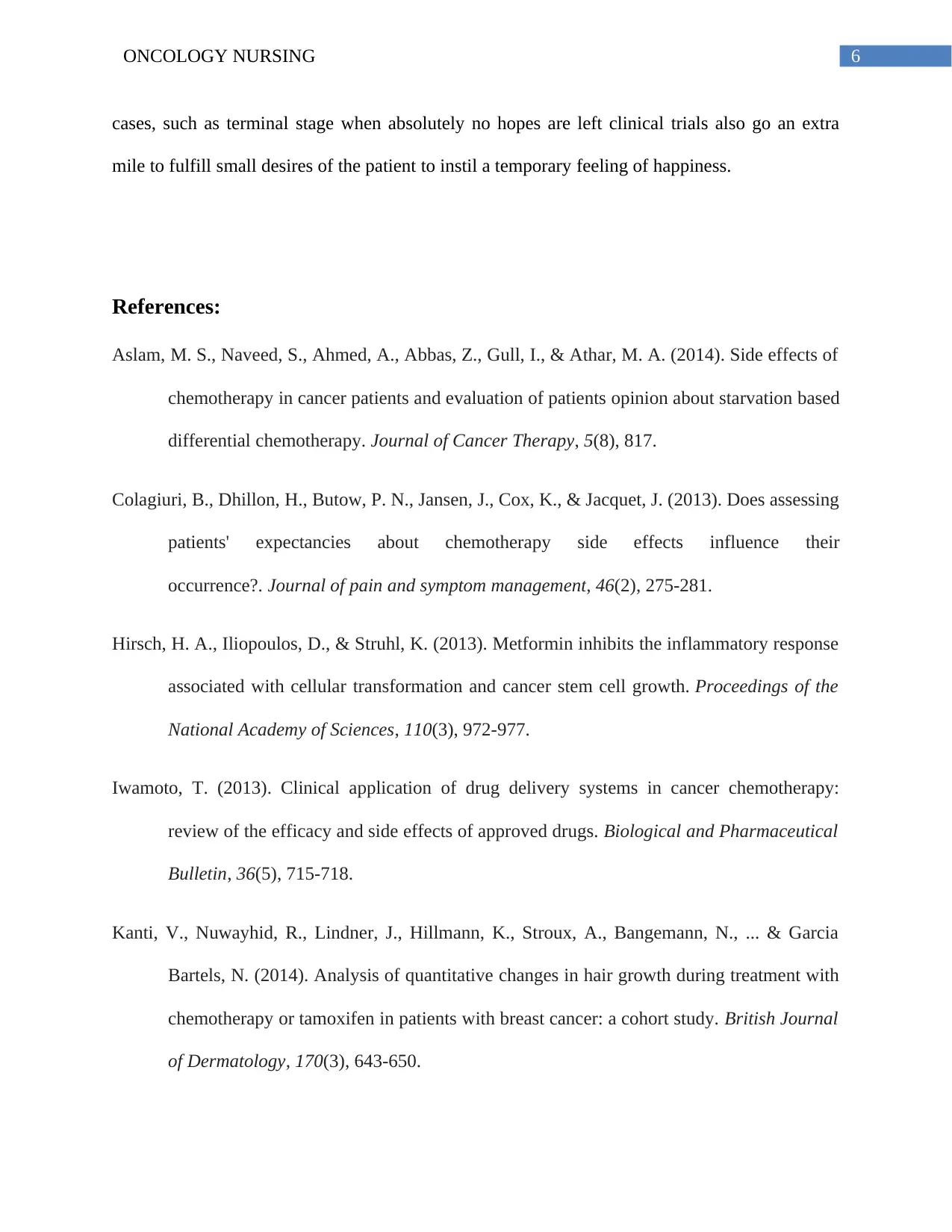
6ONCOLOGY NURSING
cases, such as terminal stage when absolutely no hopes are left clinical trials also go an extra
mile to fulfill small desires of the patient to instil a temporary feeling of happiness.
References:
Aslam, M. S., Naveed, S., Ahmed, A., Abbas, Z., Gull, I., & Athar, M. A. (2014). Side effects of
chemotherapy in cancer patients and evaluation of patients opinion about starvation based
differential chemotherapy. Journal of Cancer Therapy, 5(8), 817.
Colagiuri, B., Dhillon, H., Butow, P. N., Jansen, J., Cox, K., & Jacquet, J. (2013). Does assessing
patients' expectancies about chemotherapy side effects influence their
occurrence?. Journal of pain and symptom management, 46(2), 275-281.
Hirsch, H. A., Iliopoulos, D., & Struhl, K. (2013). Metformin inhibits the inflammatory response
associated with cellular transformation and cancer stem cell growth. Proceedings of the
National Academy of Sciences, 110(3), 972-977.
Iwamoto, T. (2013). Clinical application of drug delivery systems in cancer chemotherapy:
review of the efficacy and side effects of approved drugs. Biological and Pharmaceutical
Bulletin, 36(5), 715-718.
Kanti, V., Nuwayhid, R., Lindner, J., Hillmann, K., Stroux, A., Bangemann, N., ... & Garcia
Bartels, N. (2014). Analysis of quantitative changes in hair growth during treatment with
chemotherapy or tamoxifen in patients with breast cancer: a cohort study. British Journal
of Dermatology, 170(3), 643-650.
cases, such as terminal stage when absolutely no hopes are left clinical trials also go an extra
mile to fulfill small desires of the patient to instil a temporary feeling of happiness.
References:
Aslam, M. S., Naveed, S., Ahmed, A., Abbas, Z., Gull, I., & Athar, M. A. (2014). Side effects of
chemotherapy in cancer patients and evaluation of patients opinion about starvation based
differential chemotherapy. Journal of Cancer Therapy, 5(8), 817.
Colagiuri, B., Dhillon, H., Butow, P. N., Jansen, J., Cox, K., & Jacquet, J. (2013). Does assessing
patients' expectancies about chemotherapy side effects influence their
occurrence?. Journal of pain and symptom management, 46(2), 275-281.
Hirsch, H. A., Iliopoulos, D., & Struhl, K. (2013). Metformin inhibits the inflammatory response
associated with cellular transformation and cancer stem cell growth. Proceedings of the
National Academy of Sciences, 110(3), 972-977.
Iwamoto, T. (2013). Clinical application of drug delivery systems in cancer chemotherapy:
review of the efficacy and side effects of approved drugs. Biological and Pharmaceutical
Bulletin, 36(5), 715-718.
Kanti, V., Nuwayhid, R., Lindner, J., Hillmann, K., Stroux, A., Bangemann, N., ... & Garcia
Bartels, N. (2014). Analysis of quantitative changes in hair growth during treatment with
chemotherapy or tamoxifen in patients with breast cancer: a cohort study. British Journal
of Dermatology, 170(3), 643-650.
Paraphrase This Document
Need a fresh take? Get an instant paraphrase of this document with our AI Paraphraser

7ONCOLOGY NURSING
Loven, D., Hasnis, E., Bertolini, F., & Shaked, Y. (2013). Low-dose metronomic chemotherapy:
from past experience to new paradigms in the treatment of cancer. Drug discovery
today, 18(3-4), 193-201.
Meacham, C. E., & Morrison, S. J. (2013). Tumour heterogeneity and cancer cell
plasticity. Nature, 501(7467), 328.
Patel, M., Harrison, S., & Sinclair, R. (2013). Drugs and hair loss. Dermatologic clinics, 31(1),
67-73.
Paus, R., Haslam, I. S., Sharov, A. A., & Botchkarev, V. A. (2013). Pathobiology of
chemotherapy-induced hair loss. The Lancet Oncology, 14(2), e50-e59.
Polovich, M., Whitford, J. M., & Olsen, M. M. (Eds.). (2014). Chemotherapy and biotherapy
guidelines and recommendations for practice. Pittsburgh, PA: Oncology Nursing Society.
Rugo, H. S., Klein, P., Melin, S. A., Hurvitz, S. A., Melisko, M. E., Moore, A., ... & Ver Hoeve,
E. S. (2017). Association between use of a scalp cooling device and alopecia after
chemotherapy for breast cancer. Jama, 317(6), 606-614.
Sui, X., Chen, R., Wang, Z., Huang, Z., Kong, N., Zhang, M., ... & Wang, X. (2013). Autophagy
and chemotherapy resistance: a promising therapeutic target for cancer treatment. Cell
death & disease, 4(10), e838.
Loven, D., Hasnis, E., Bertolini, F., & Shaked, Y. (2013). Low-dose metronomic chemotherapy:
from past experience to new paradigms in the treatment of cancer. Drug discovery
today, 18(3-4), 193-201.
Meacham, C. E., & Morrison, S. J. (2013). Tumour heterogeneity and cancer cell
plasticity. Nature, 501(7467), 328.
Patel, M., Harrison, S., & Sinclair, R. (2013). Drugs and hair loss. Dermatologic clinics, 31(1),
67-73.
Paus, R., Haslam, I. S., Sharov, A. A., & Botchkarev, V. A. (2013). Pathobiology of
chemotherapy-induced hair loss. The Lancet Oncology, 14(2), e50-e59.
Polovich, M., Whitford, J. M., & Olsen, M. M. (Eds.). (2014). Chemotherapy and biotherapy
guidelines and recommendations for practice. Pittsburgh, PA: Oncology Nursing Society.
Rugo, H. S., Klein, P., Melin, S. A., Hurvitz, S. A., Melisko, M. E., Moore, A., ... & Ver Hoeve,
E. S. (2017). Association between use of a scalp cooling device and alopecia after
chemotherapy for breast cancer. Jama, 317(6), 606-614.
Sui, X., Chen, R., Wang, Z., Huang, Z., Kong, N., Zhang, M., ... & Wang, X. (2013). Autophagy
and chemotherapy resistance: a promising therapeutic target for cancer treatment. Cell
death & disease, 4(10), e838.
1 out of 8
Related Documents
Your All-in-One AI-Powered Toolkit for Academic Success.
+13062052269
info@desklib.com
Available 24*7 on WhatsApp / Email
![[object Object]](/_next/static/media/star-bottom.7253800d.svg)
Unlock your academic potential
Copyright © 2020–2025 A2Z Services. All Rights Reserved. Developed and managed by ZUCOL.





